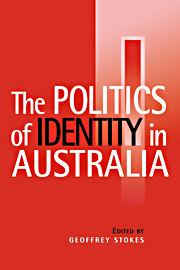Book contents
- Frontmatter
- Contents
- Acknowledgements
- Contributors
- Introduction
- Theorising Identity
- Gender and Sexuality
- 4 ‘Manly, True and White’: Masculine Identity and Australian Socialism
- 5 ‘Stirring Tales’: Australian Feminism and National Identity, 1900–40
- 6 The Making of an Australian Civic Identity: The Bodies of Men and the Memory of War
- 7 (Homo) sexual Identities, Queer Theory and Politics
- Race, Place and Citizenship
- Culture: Literature and Film
- References
- Index
6 - The Making of an Australian Civic Identity: The Bodies of Men and the Memory of War
Published online by Cambridge University Press: 05 June 2012
- Frontmatter
- Contents
- Acknowledgements
- Contributors
- Introduction
- Theorising Identity
- Gender and Sexuality
- 4 ‘Manly, True and White’: Masculine Identity and Australian Socialism
- 5 ‘Stirring Tales’: Australian Feminism and National Identity, 1900–40
- 6 The Making of an Australian Civic Identity: The Bodies of Men and the Memory of War
- 7 (Homo) sexual Identities, Queer Theory and Politics
- Race, Place and Citizenship
- Culture: Literature and Film
- References
- Index
Summary
The use of and traffic in women subtend and uphold the reign of masculine hom(m)o-sexuality, even while they maintain that hom(m)o-sexuality in speculations, mirror games, identifications, and more or less rivalrous appropriations, which defer its real practice. Reigning everywhere, although prohibited in practice, hom(m)o-sexuality is played out through the bodies of women, matter, or sign, and heterosexuality has been up to now just an alibi for the smooth workings of man's relations with himself, of relations among men.
(Irigaray 1985:172)If only there were a way to start a city or an army made up of lovers and the boys they love! Theirs would be the best possible system of society, for they would hold back from all that is shameful, and seek honor in each other's eyes. Even a few of them, in battle side by side, would conquer all the world, I'd say. For a man in love would never allow his loved one, of all people, to see him leaving ranks or dropping weapons. He'd rather die a thousand deaths! And as for leaving the boy behind, or not coming to his aid in danger – why, no one is so base that true Love could not inspire him with courage, and make him as brave as if he'd been born a hero.
(Phaedrus, in Plato 1989:178e–179b)My aim here is to suggest connections between war and masculinity in the elaboration of Australian civic identity. The linkage between the violence of war and masculinity is almost too obvious to belabour.
- Type
- Chapter
- Information
- The Politics of Identity in Australia , pp. 92 - 104Publisher: Cambridge University PressPrint publication year: 1997

